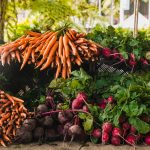Pressure cookers have emerged as time-saving heroes in the kitchen, earning a place in the culinary arsenal of many home cooks. These powerful pots harness the power of pressure to drastically reduce cooking times, making them a highly efficient tool for preparing complex dishes. But how does it do this? To understand the time-saving marvel that is the pressure cooker, it is crucial to delve into its mechanics, understand how pressure affects cooking, and explore the types of foods that benefit from this method of cooking.
The Mechanics of a Pressure Cooker
A pressure cooker is a sealed pot that creates pressure by trapping steam produced from boiling liquid, typically water. As you fill the pot with food and water and seal the lid, the heat source causes the liquid to boil, creating steam.
Have you seen this : How to choose the right size freezer for a family of four?
When you heat water in a regular pot, the heat dissipates, and the water steams at 212°F (100°C). However, since the pressure cooker is sealed, the trapped steam increases the internal pressure, allowing the temperature to rise beyond the natural boiling point of water.
This is where the science of the pressure cooker comes into play. The pressure inside the pot is measured in pounds per square inch (psi). At sea level, normal atmospheric pressure is approximately 14.7 psi. A high-end pressure cooker can reach a pressure of about 15 psi above atmospheric pressure, which corresponds to a temperature around 250°F (121°C). That’s a significant increase in heat, which, coupled with the steam’s penetration, accelerates the cooking process.
Additional reading : Indulge in authentic french butter: buy online today!
Time Savings with Pressure Cooking
So how does this pressure translate into faster cooking times? It all comes down to the relationship between pressure, heat, and time. In standard cooking methods, the heat slowly penetrates the food from the outside in. This process can take a considerable amount of time, especially for dense foods like meats or beans.
However, in a pressure cooker, the high pressure forces the steam and heat into the food, cooking it evenly and quickly. This method can reduce cooking times by up to 70% when compared to conventional cooking methods. For example, a pot roast that would typically take three hours to cook in the oven can be tender and ready in about 45 minutes in a pressure cooker.
Different Foods, Different Pressures
Pressure cookers come with settings to adjust the pressure level, allowing you to alter the heat and cooking time to suit the type of food you’re preparing. Most electric models offer settings for high pressure (10-15 psi) and low pressure (6-8 psi).
High pressure is ideal for tough, dense foods like meat, while low pressure is perfect for delicate foods like fish or vegetables. Thus, it’s essential to adjust the pressure level according to the food you are cooking, ensuring it cooks properly without becoming overdone or losing its nutritional value.
Natural Release vs. Quick Release
Another interesting aspect of pressure cooking is the method of releasing the steam once cooking is complete. This can also impact the cooking time and the texture of the foods.
The first method is a natural release, where you remove the pot from the heat and allow the pressure to decrease gradually. This process can take 10 to 20 minutes, but it is recommended when cooking liquids, grains, or any foods that expand and foam.
The second method is a quick release, where you open the steam valve and allow the steam to escape quickly. This method cools the cooker in a matter of minutes, which is suitable for stopping the cooking process instantly to prevent overcooking of foods.
Cooking Complex Dishes with a Pressure Cooker
Complex dishes that traditionally take hours to prepare can be made in a fraction of the time using a pressure cooker. Stews, roasts, curries, and even desserts that require slow cooking to develop flavors can be made quickly without compromising the taste.
For example, a beef stew that would usually simmer for two to three hours can be done in about 30 minutes in a pressure cooker. Similarly, risottos that require constant stirring and attention can be prepared without much fuss, saving time and effort. The pressurized steam not only cooks the food quickly but also locks in the flavors, resulting in richer, more flavorful dishes.
Remember, while pressure cooking is significantly faster, the total time also includes the time required for the cooker to reach the desired pressure and the time to release the steam. However, even with these factors considered, pressure cooking can slash your time in the kitchen, making it a handy tool for whipping up complex dishes quickly.
The allure of pressure cooking lies in its simplicity and efficiency. With a little practice, you’ll be able to serve up a variety of delightful meals faster and more efficiently than traditional cooking methods ever allowed. So why not embrace the pressure, and let the cooker do the hard work for you?
The Versatility of Pressure Cookers
A pressure cooker is not just a tool for speeding up the cooking process; it is a versatile kitchen gadget that can be used for a variety of cooking tasks. Its ability to maintain consistent high heat and pressure makes it ideal for a range of recipes that would otherwise require long hours of simmering, baking or roasting.
For instance, you can use pressure cookers to make soups, stews, and broths. These dishes typically require extended cooking times to break down the tough fibers in meat and vegetables to extract their full flavor. But when cooked in a pressure cooker, the high pressure and temperature accelerate this process, significantly reducing their cooking times.
Pressure cookers are equally efficient for cooking grains like rice, quinoa, or oatmeal. Unlike traditional methods that require constant monitoring to prevent boiling over or burning, a pressure cooker maintains a consistent temperature and pressure that evenly cooks the grains without the need for constant supervision.
Pressure cookers are also renowned for their ability to tenderize tough cuts of meat. Traditionally, these would need to be slow-cooked for several hours to achieve the desired tenderness. But in a pressure cooker, the same results can be achieved in a fraction of the time, preserving the meat’s flavor and moisture.
Finally, pressure cookers can also be used for preparing desserts. Whether it’s a creamy rice pudding, a succulent fruit compote, or a soft and gooey chocolate cake, a pressure cooker can handle it all. And because it cooks under pressure, it ensures that the flavors are locked in, resulting in a richer, more intense taste.
Conclusion: Embracing Pressure Cooking for Complex Dishes
In conclusion, pressure cooking offers a convenient and efficient way to prepare complex dishes in less time. Its science-based cooking method uses high pressure and temperature to reduce cooking times by up to 70%, making it ideal for busy individuals who love homemade meals but are pressed for time.
Moreover, pressure cookers are incredibly versatile, capable of cooking a vast array of foods, from tough meats and grains to delicate vegetables and desserts. With the ability to adjust the pressure level, you can ensure that your food cooks perfectly every time, whether you’re making a robust beef stew or a delicate fish fillet.
Finally, the pressure cooker’s natural and quick release methods offer control over the cooking process, allowing you to adjust the cooking time and texture of your foods. This feature, along with its ability to lock in flavors, makes pressure cooking an excellent choice for cooking delicious, flavorful dishes.
So whether you have an Instant Pot, a Ninja Foodi, or a traditional stovetop pressure cooker, it’s time to embrace the power and efficiency of pressure cooking. With time, you’ll master the art of pressure cooking, and your kitchen will transform into a place where complex dishes come together in a snap.
Thus, a pressure cooker is more than just a cooking pot. It’s a game-changer, a time-saver, and a culinary wizard that can help you create delicious meals in less time than you ever imagined. So why wait? Start your pressure cooking journey today, and discover the joy of cooking with pressure.






